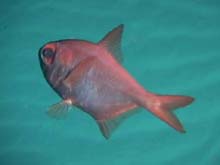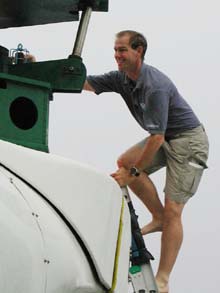
The “alphonsin” Beryx decadactylus. Though prized as a “food fish” in some parts of the world, there is no targeted fishery for the species in Hawai'i. Individuals are found too deep and are too sparse to be profitable. Click image for larger view.
Diving with Frank
September 21, 2002
Ray Boland, Biologist
National Marine Fisheries Service
Frank has never failed me. This doesn't mean that all my experiences with Frank are positive ones -- it's just that he has never failed to give me experience. Since you don't know Frank, I'll introduce him to you.
Frank Alan Parrish was born on March 29, 1963. An avid scuba diver, he began work with NOAA's National Marine Fisheries Service in 1987. He is presently a fisheries biologist for the Ecosystems and Environment Investigation, and is working on Hawaiian monk seal forage bases and several other small projects on reef- fish populations in the Northwestern Hawaiian Islands (NWHI). Two things in Frank's life are 5 yrs younger than him, and, though minor annoyances, still provide good service. One is his 1968 Datsun Roadster, which, despite a lack of replacement parts, he has kept running; the other is the author of this narrative.
I did my first reef-fish survey in the NWHI in 1990 for one of Frank's projects. Except for two yrs in the mid 90s, most of the fish-counting projects I have worked on have been Frank's projects. Due to Frank, I have accumulated a whole year's worth of time in the NWHI, at sea, diving to all kinds of depths (as deep as 240 ft), in all kinds of weather, from all kinds of boats (most floating, but two did try to sink on us), in all kinds of conditions (murky, clear, current, no current, reef, no reef, mud, algae), and with all kinds of critters (sharks, seals, Ulua, turtles, and countless reef fish). Frank has always, albeit unwittingly, provided me with some sort of adventure. That's one of the reasons why I stuck it out -- the pay was okay, but the jobs have always been cool. So I wasn't surprised when the submersible Pisces IV got caught in currents throughout the dive. No matter which direction we tried to head, a powerful current would nearly overpower the sub's thrusters. Whose survey were we conducting? Why, Frank's, of course.

Frank Parrish braves the driving rain as he climbs into the Pisces IV for his first dive on the Northampton Seamounts. Click image for larger view.
Now, counting fish can be a bit of a challenge. Everyone I've met always asks me how I make sense of schools of fish. Basically, you start at one end, and count really quickly. If they're moving, I pick a spot in the water column. It's sort of like counting sheep jumping over a fence. Our surveys are done in what is called a “belt transect.” While diving, we run out a 50-m tape, and count fish along it, within a certain width from it. You get pretty good at estimating distance from the tape, so you know that your strip width is good. But that is not where it ends. We also estimate the size of a fish on a belt transect. Mostly, it's giving an estimate on the length of the fish. You get pretty good at it after a while, and you can most certainly tell the difference between a fish that's 5 cm long fish and one that's 7 cm long. I've done many belt transects counting fish and estimating their size while scuba diving. This has led to two excellent skills: I've become a pretty good diver, and I can identify a reef fish, count it, and estimate its size all within a matter of seconds.
Conducting a transect from a submersible is much easier. First, you don't really have to worry about your air running out. Second, you don't have to deploy and retrieve a tape. Third, you needn't worry about transect width, because whatever appears in the submersible's lights is what you count. Fourth, nothing can eat you while you are diving in a submersible. You do, however, have to worry about not being able to use the bathroom for 8 hrs. Also, I had to learn all of the deep-water fishes, corals and invertebrates, but I always see something I can't identify. Well, I guess I learned most of the fishes, corals and invertebrates.
There are things that don't change, and diving with Frank, either wet or dry, is sure to be an adventure. Today, wherever we went, including up, the currents were against us. This made it slow going, but we were still able to conduct our surveys. The sub did, however, get pinned up against a wall by a current at one point. We also stumbled into an amazingly huge bed of gold coral and bamboo coral. It was fantastic and beautiful. Once again, Frank did not disappoint.
Sign up for the Ocean Explorer E-mail Update List.




















